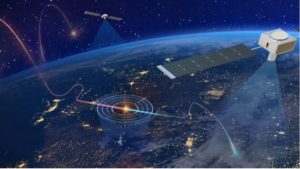Last week, Rep. Mike Rogers (R-Ala.) pushed Defense Department officials on why funds for a hyperosnic missile defense sensor were moved from the Missile Defense Agency (MDA) to the Space Development Agency (SDA).
During a March 12 hearing before the House Armed Services Strategic Forces subcommittee, Rogers asked MDA director Adm. Jon Hill for clarification on which agency will work on the Hypersonic and Ballistic Tracking Space Sensor (HBTSS) program since the fiscal year 2020 authorization bill directed it be led by MDA, but the FY ’21 funding request pushes the program to the SDA.

Hill said while MDA has received funds over the last several years to develop the system, the department decided to move the funds from MDA to SDA in this next year.
HBTSS aims to augment the military’s early missile warning satellite constellations like the Space-Based Infrared Sensors (SBIRS) and forthcoming Next-Generation Overhead Persistent Infrared (OPIR) to help detect and track hypersonic weapons from space.
When Rogers pressed on who made the decision, Hill said it was Under Secretary of Defense for Research and Engineering Michael Griffin. However, Hill added the agencies are working well together.
“I believe it was recommended by Dr. Griffin–he mentioned that recently in public,” he said. “What he was trying to do…he’s trying to consolidate the dollars for space because it’s such an important capability we need.”
“So by having it run by basically the architect of the proliferated capability, [Derek Tournear], as the director of SDA, there’s no light between us. We’re working very, very close,” Hill continued.
Hill said he recognized Congress is concerned with “visibility into how these dollars are leveraged and making sure that MDA is in charge of building that sensor” but confirmed MDA will still build it, even if it is overseen overall by SDA.
“There has been no change in that strategy for MDA to remain the developer for that sensor and to provide that to SDA as part of their architecture,” Hill said.
Rogers responded, “I like Dr. Griffin, but he should have come back to us and talk to us about that before the decision was made.”
Rogers again asked how it works that under the FY ’21 budget request SDA gets the funding but MDA does the work.
“The intent is for SDA to provide funding back to MDA so continue the development work and provide the sensors to the SDA architecture.”
Separately, Hill said he thinks MDA is making significant progress on HBTSS.
He noted the agency has worked through the analysis of alternatives, concept of operations, and what it thinks is the highest risk as “how do you deal with clutter, when you’re looking down from space and you’re trying to track things that are maneuvering globally.”
Hill said MDA is now moving toward a demonstration of signal chain processing in HBTSS.
Last year, four companies won $20 million contracts each to develop prototype payload designs for the HBTSS program: Northrop Grumman [NOC], Leidos [LDOS], L3Harris Technologies, and Raytheon [ RTN]. The final designs are due to MDA by Oct. 21, 2020 (Defense Daily, Nov. 1, 2019).
In 2018, Griffin explained the only way to reliably track hypersonic weapons from Low Earth Orbit is with a new space sensor layer. Because the hypersonic weapons are a factor of 10 times dimmer than strategic ballistic missiles currently tracked, the sensors have to operate at lower orbits than previous tracking constellations (Defense Daily, Aug. 8, 2018).